
KENYA: For years, farmers in Mwea had to contend with disposal of massive rice husks and stalks after harvesting their crop.
But the waste product is slowly turning into some gem. Some creative entrepreneurs have discovered this waste can serve as affordable and nutritious animal feed. Previously, the stalks were burned to ashes within the rice paddies immediately after the harvesting season. The product is being exported to as far as Saudi Arabia. Rose Wairimu is one of the farmers from the vast Mwea Irrigation Scheme, who have discovered this new venture.







